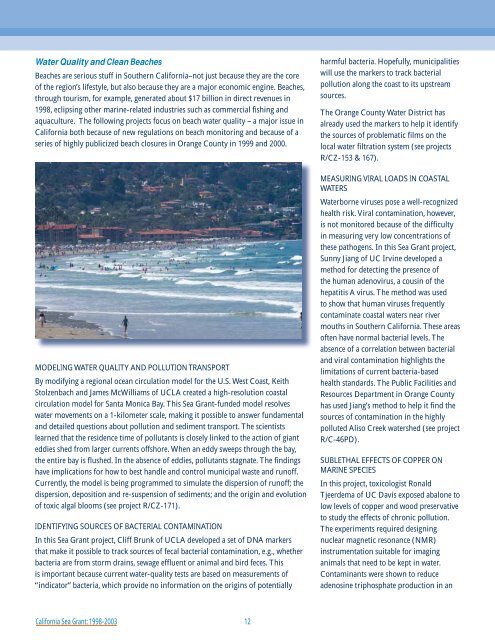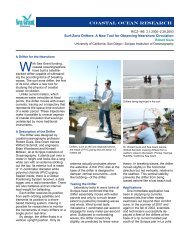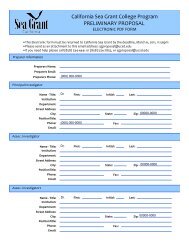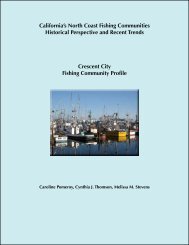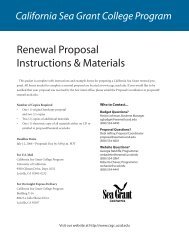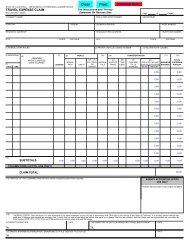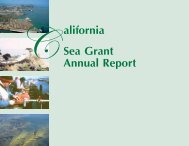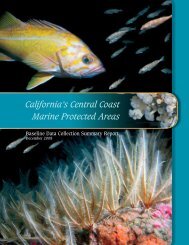PAT-UC Covers - California Sea Grant - UC San Diego
PAT-UC Covers - California Sea Grant - UC San Diego
PAT-UC Covers - California Sea Grant - UC San Diego
Create successful ePaper yourself
Turn your PDF publications into a flip-book with our unique Google optimized e-Paper software.
Water Quality and Clean Beaches<br />
Beaches are serious stuff in Southern <strong>California</strong>–not just because they are the core<br />
of the region’s lifestyle, but also because they are a major economic engine. Beaches,<br />
through tourism, for example, generated about $17 billion in direct revenues in<br />
1998, eclipsing other marine-related industries such as commercial fishing and<br />
aquaculture. The following projects focus on beach water quality – a major issue in<br />
<strong>California</strong> both because of new regulations on beach monitoring and because of a<br />
series of highly publicized beach closures in Orange County in 1999 and 2000.<br />
MODELING WATER QUALITY AND POLLUTION TRANSPORT<br />
By modifying a regional ocean circulation model for the U.S. West Coast, Keith<br />
Stolzenbach and James McWilliams of <strong>UC</strong>LA created a high-resolution coastal<br />
circulation model for <strong>San</strong>ta Monica Bay. This <strong>Sea</strong> <strong>Grant</strong>-funded model resolves<br />
water movements on a 1-kilometer scale, making it possible to answer fundamental<br />
and detailed questions about pollution and sediment transport. The scientists<br />
learned that the residence time of pollutants is closely linked to the action of giant<br />
eddies shed from larger currents offshore. When an eddy sweeps through the bay,<br />
the entire bay is flushed. In the absence of eddies, pollutants stagnate. The findings<br />
have implications for how to best handle and control municipal waste and runoff.<br />
Currently, the model is being programmed to simulate the dispersion of runoff; the<br />
dispersion, deposition and re-suspension of sediments; and the origin and evolution<br />
of toxic algal blooms (see project R/CZ-171).<br />
IDENTIFYING SOURCES OF BACTERIAL CONTAMINATION<br />
In this <strong>Sea</strong> <strong>Grant</strong> project, Cliff Brunk of <strong>UC</strong>LA developed a set of DNA markers<br />
that make it possible to track sources of fecal bacterial contamination, e.g., whether<br />
bacteria are from storm drains, sewage effluent or animal and bird feces. This<br />
is important because current water-quality tests are based on measurements of<br />
“indicator” bacteria, which provide no information on the origins of potentially<br />
harmful bacteria. Hopefully, municipalities<br />
will use the markers to track bacterial<br />
pollution along the coast to its upstream<br />
sources.<br />
The Orange County Water District has<br />
already used the markers to help it identify<br />
the sources of problematic films on the<br />
local water filtration system (see projects<br />
R/CZ-153 & 167).<br />
MEASURING VIRAL LOADS IN COASTAL<br />
WATERS<br />
Waterborne viruses pose a well-recognized<br />
health risk. Viral contamination, however,<br />
is not monitored because of the difficulty<br />
in measuring very low concentrations of<br />
these pathogens. In this <strong>Sea</strong> <strong>Grant</strong> project,<br />
Sunny Jiang of <strong>UC</strong> Irvine developed a<br />
method for detecting the presence of<br />
the human adenovirus, a cousin of the<br />
hepatitis A virus. The method was used<br />
to show that human viruses frequently<br />
contaminate coastal waters near river<br />
mouths in Southern <strong>California</strong>. These areas<br />
often have normal bacterial levels. The<br />
absence of a correlation between bacterial<br />
and viral contamination highlights the<br />
limitations of current bacteria-based<br />
health standards. The Public Facilities and<br />
Resources Department in Orange County<br />
has used Jiang’s method to help it find the<br />
sources of contamination in the highly<br />
polluted Aliso Creek watershed (see project<br />
R/C-46PD).<br />
SUBLETHAL EFFECTS OF COPPER ON<br />
MARINE SPECIES<br />
In this project, toxicologist Ronald<br />
Tjeerdema of <strong>UC</strong> Davis exposed abalone to<br />
low levels of copper and wood preservative<br />
to study the effects of chronic pollution.<br />
The experiments required designing<br />
nuclear magnetic resonance (NMR)<br />
instrumentation suitable for imaging<br />
animals that need to be kept in water.<br />
Contaminants were shown to reduce<br />
adenosine triphosphate production in an<br />
<strong>California</strong> <strong>Sea</strong> <strong>Grant</strong>: 1998-2003<br />
12


